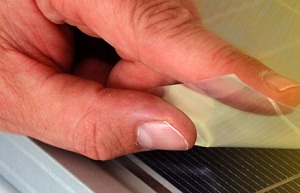Colo. company makes solar for less
 Soloptics, a division of Genie Lens Technologies, LLC, said its FUSION surface technology increases photovoltaic performance for roughly 10 cents per watt. The company announced the results after the product was tested at the National Renewable Energy Laboratory. So, when the technology comes to market, installing the solar technology on an existing 2.5 kilowatt PV system (home-sized) would cost about $250.
Soloptics, a division of Genie Lens Technologies, LLC, said its FUSION surface technology increases photovoltaic performance for roughly 10 cents per watt. The company announced the results after the product was tested at the National Renewable Energy Laboratory. So, when the technology comes to market, installing the solar technology on an existing 2.5 kilowatt PV system (home-sized) would cost about $250.
According to Soloptics, the FUSION technology has proved to increase the performance of PVs by 10 percent to 12.5 percent, depending on testing conditions. The Englewood, Colo.-based company said that the gains were realized regardless of the PV materials used, whether they were silicon or thin-film based.
The technology uses optical microstuctures that are embossed in a glass or polymer layer to boost the level of PV conversion efficiency. The optics in the FUSION layer increase the angle at which sunlight penetrates the PV cell, and refracts it within the cell instead of reradiating it off the surface of the cell.
The technology is applicable for existing PV modules and can be built in to new PV modules to help increase their efficiency. For existing PV modules, FUSION can be added as a thin polymer film that’s glued to the module directly. While the technology can be engineered directly into the glass layer used in most commercial PV panels.
"The FUSION product shows significant improvement in the current technology, particularly under various low level lighting conditions," Keith Emery, Principal Research Supervisor at the Outdoor Test Facility, said in a prepared statement.
Soloptics said FUSION was developed in a generic form so that it is applicable to a wide cross-section of the PV market and was designed with flexibility in mind. The company added that the technology can be adapted “based on specific requirements.” These include factors like being adapted to either higher or lower conditions, as well as targeted wavelength filtering or specifications of panel manufacturers.
The technology is inexpensive because it can be produced using existing technology and inexpensive materials, making ideal for retrofitting existing modules and incorporating it into new modules. With the added boost in performance, FUSION should quickly pay for itself.
The company did not offer a timeline for when it expected the technology to be commercially available.



